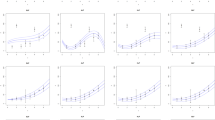Abstract
We apply our new fuzzy Monte Carlo method to a certain fuzzy linear regression problem to estimate the best solution. The best solution is a vector of triangular fuzzy numbers, for the fuzzy coefficients in the model, which minimizes one of two error measures. We use a quasi-random number generator to produce random sequences of these fuzzy vectors which uniformly fill the search space. We consider an example problem and show this Monte Carlo method obtains the best solution for one error measure and is approximately best for the other error measure.
Similar content being viewed by others
References
Choi SH, Buckley JJ (2007) Fuzzy regression using least absolute deviation estimators. Soft Comput (to appear)
Buckley JJ, Eslami E (2002) Introduction to fuzzy logic and fuzzy sets. Springer, Heidelberg
Buckley JJ (2007) Monte Carlo studies with random fuzzy numbers. Springer, Heidelberg (to appear)
Cheng C-B (2001) Fuzzy regression analysis by a fuzzy neural network and its application to dual response optimization. In: Proceedings joint 9th IFSA World congress and 20th NAFIPS international Conference, Vancouver, Canada, Vol 5, pp 2681–2686
D’Urso P (2003) Linear regression analysis for fuzzy/crisp input and fuzzy/crisp output data. Comput Stat Data Anal 42:47–72
Feuring T, Golubski W, Gassmann M (2000) Fuzzy regression: a genetic programming approach. In: Fourth international Conference knowledge-based intelligent engineering systems and allied technologies, Aug 30–Sept 1, Brighton, UK
Henderson SG, Chiera BA, Cooke RM (2000) Generating “dependent” quasi-random numbers. In: Proceedings of the 2000 winter simulation conference, Orlando, FL, Dec 10–13, pp 527–536
Hogg RV, Tanis EA (2001) Probability and statistical inference, 6th edn. Prentice Hall, Upper Saddle River
Kim B, Bishu RR (1998) Evaluation of fuzzy linear regression models by comparing membership functions. Fuzzy Sets Syst 100:343–352
Lindgren BW (1976) Statistical theory, 3rd edn. MacMillan, New York
Press WH, Flannery BP, Teukolsky SA, Vetterling WT (2002): Numerical recipes in C: the art of scientific computing, 6th edn. Cambridge University Press, Cambridge
Savic DA, Pedryzc W (1991) Evaluation of fuzzy linear regression models. Fuzzy Sets Syst 39:51–63
Tanaka H (1987) Fuzzy data analysis by possibilistic linear regression models. Fuzzy Sets Syst 24:363–375
Author information
Authors and Affiliations
Corresponding author
Rights and permissions
About this article
Cite this article
Abdalla, A., Buckley, J.J. Monte Carlo methods in fuzzy linear regression. Soft Comput 11, 991–996 (2007). https://doi.org/10.1007/s00500-006-0148-5
Published:
Issue Date:
DOI: https://doi.org/10.1007/s00500-006-0148-5




